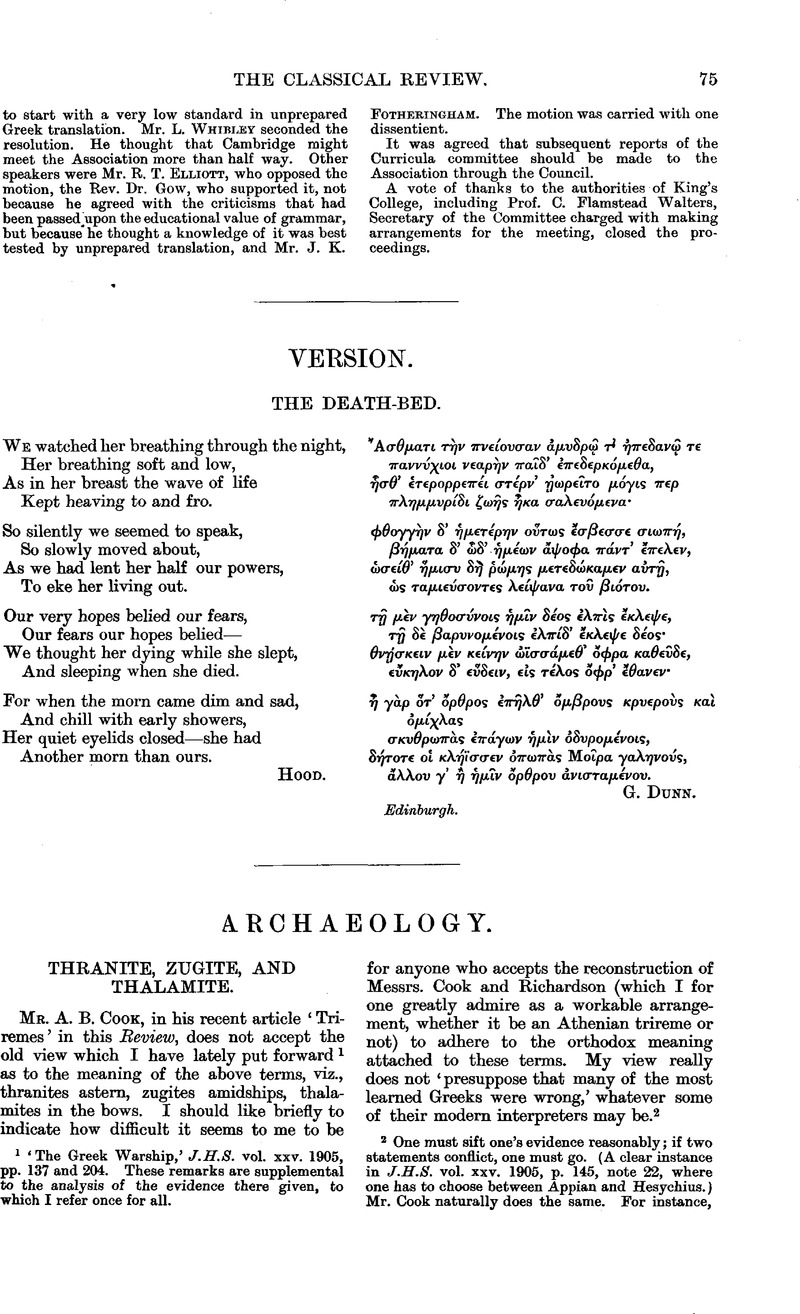No CrossRef data available.
Article contents
Archaeology
Published online by Cambridge University Press: 27 October 2009
Abstract

- Type
- Other
- Information
- Copyright
- Copyright © The Classical Association 1906
References
page 75 note 1 ‘The Greek Warship,’ J.H.S. vol. xxv. 1905, pp. 137 and 204. These remarks are supplemental to the analysis of the evidence there given, to which I refer once for all.
page 75 note 2 One must sift one's evidence reasonably; if two statements conflict, one must go. (A clear instance in J.H.S. vol. xxv. 1905, p. 145, note 22, where one has to choose between Appian and Hesychius.) Mr. Cook naturally does the same. For instance, Eustathius says the thalamites are under (ὑπ) the thranites: Mr. Cook discards this as directly as I do; see his model. (Is it possible that νπó should mean ‘forward of,’ comparing Polyb. 16, 3, ![]() , where ‘forward of’ would make far better sense than ‘under’?) As a fact, I have discarded extremely little.
, where ‘forward of’ would make far better sense than ‘under’?) As a fact, I have discarded extremely little.
page 76 note 1 ![]()
page 76 note 2 Of course not a trireme, at that date. It is worth noting that, even if this ship were only a quadrireme (as was, e.g., the Roman flagship at Side), the passage would be quite inconsistent with Dr. Assmann's arrangement, which would make the top bank of a quadrireme also ‘thalamites.’ Pollux 1, 87 anyhow clearly forbids Dr. Assmann's arrangement.
page 76 note 3 ![]()
page 76 note 4 There is an alternative, viz., to say that the writers of the second century A.D. did not know what they were talking about. But anyone saying this must never cite scholia.
page 77 note 1 I Have Already made a very brief preliminary statement in Berl. Phil. Wochenschrift for Jan. 27, 1906; since writing it, my views have changed in several particulars.
page 78 note 1 The drawings accompanying this article were prepared under my direction by my friend Mr. Henry A. Boehm, of the American Academy in Rome; they are not based on actual measurements except in certain details, but in general give a correct idea of the relative size and position of the remains. The outlines of Castor IV. are traced from Tognetti's drawings in the Jahrbuch for 1898, Pis. 8, 9. In referring to these plans I follow the customary convention and speak of the Castor temple as if facing N., and the Concord temple as if facing E.
page 78 note 2 These distances are approximate when given in feet, but exact when given in metres.
page 79 note 1 Possibly 6—they are in part still covered by the later concrete.
page 79 note 2 Except where bits of the Augustan concrete seem to have adhered.
page 80 note 1 Except at the front, where it was broken down somewhat.
page 80 note 2 At F there is a mass of concrete quite distinct from the Augustan concrete, but with a larger proportion of travertine chips than elsewhere in III.
page 81 note 1 On the question of the platform, see Richter, ibid. pp. 107 ff.
page 81 note 2 One of them measures 240 m. wide × l.70 m. deep.
page 81 note 3 Travertine chips and red pozzolana are used very freely in the concrete.
page 82 note 1 It is rather hard to think of a platform in front, wider than the temple itself.
page 83 note 1 There was apparently another similar corridor in the N. part of the cella.
page 83 note 2 I feel reasonably sure that the concrete is not laid against the tufa opus quadratum at this point, but that the latter was put in place in a hole cut for it in the concrete; this is in part quite evident now, and in part we must wait for further excavations to make the state of things perfectly clear.
page 84 note 1 Cf. Hülsen, Röm. Mitth. 1905, p. 28.
page 84 note 2 Although the bases IVb and IVc are not necessarily of the same period.
page 84 note 3 Cf. R. Lanciani, Ruins and Excavations, pp. 44, 45.
page 89 note 1 I feel to the full the force of Prof. Dörpfeld's protest against the use of the term ‘Minoan.’ The name of a person is not a good label for a period that covered many generations. But his suggestion that for ‘Minoan’ we should substitute ‘Karian’ opens up questions too wide for discussion here; see his ‘Kretische, Mykenische und Homerische Palaste,’ Ath. Mitt. 1905, p. 295.
page 91 note 1 Acadimie des Inscr. July-August, 1905.


